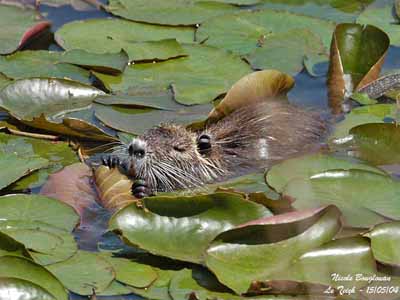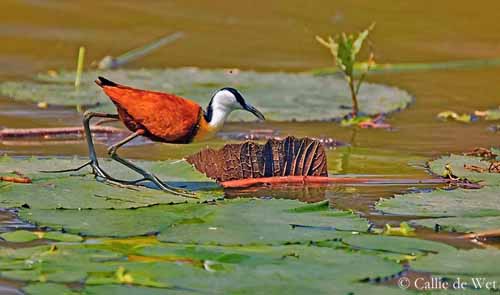
Fr: Jacana à poitrine dorée
All : Blaustirn-Blatthühnchen
Esp : Jacana Africana
Ital: Jacana africana
Nd: Lelie-loper
Sd: Afrikansk jacana
Photographers:
Photographes:
Didier Buysse
Vision d’Oiseaux
David Nowell
GALLERY
Jean Marc Rabby
Des Ailes et des Plumes
Callie de Wet
GALLERY
Text and picture of the nutria by Nicole Bouglouan
Sources:
HANDBOOK OF THE BIRDS OF THE WORLD Volume 3 by Josep del Hoyo-Andrew Elliott-Jordi Sargatal - Lynx Edicions - ISBN : 8487334202
BIRDS OF AFRICA SOUTH OF THE SAHARA by Ian Sinclair and Peter Ryan - Princeton University Press Princeton and Oxford - ISBN: 0691118159
ROBERTS BIRDS OF SOUTH AFRICA by G. R. Mc Lachlan and R. Liversidge – The Trustees of the John Voelcker Bird Book Fuund – ISBN: 0620031182
BIRDS OF THE GAMBIA AND SENEGAL by Clive Barlow and Tim Wacher – Helm Field guides – ISBN: 0713675497
BirdLife International (BirdLife International)
African Jacana
Actophilornis africanus
Charadriiforme Order – Jacanidae Family
BIOMETRICS:
Length: 23-31 cm
Weight:: M: 137 g – F: 260 g
DESCRIPTION:
The African Jacana favours the freshwater wetlands with floating vegetation where it can move easily thanks to the long toes. In this species, the female is larger than the male, and their mating system is reversed.

The adult has rich chestnut to rufous-cinnamon upperparts, but rump and secondaries are darker and primaries are black. The upperwing shows glossy sheen in good lighting. The black hindneck contrasts with the white foreneck. The tail is short.
The underparts are darker maroon-chestnut, except the chin, throat and foreneck which are white, turning golden yellow on the upper breast.
On the head, the pale blue bill extends to a large pale blue to grey blue frontal shield. The rest of the crown is black. The head sides are white. The eyes are dark brown.
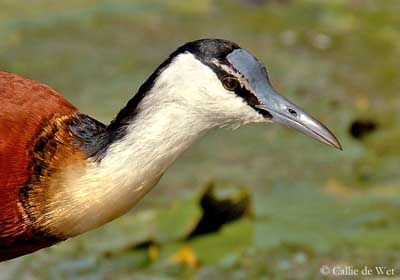
The long legs and the very long toes are greyish-blue to olive-brown.
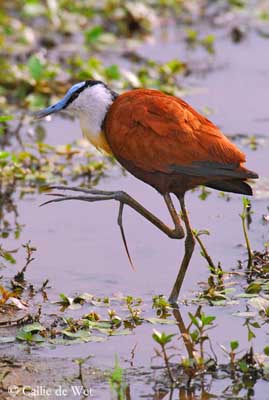
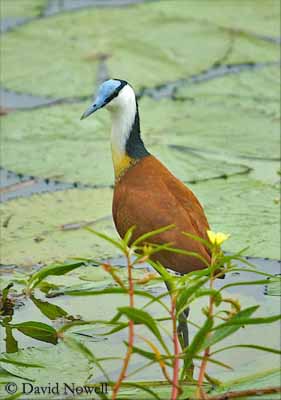
The female has similar plumage but she is larger than the male.
The immature has blackish washed brown crown and hindneck.
It has a white supercilium and the frontal shield is absent or slightly developed.
The upperparts are pale brown. The underparts are white, and we can see an indistinct yellowish breast band.
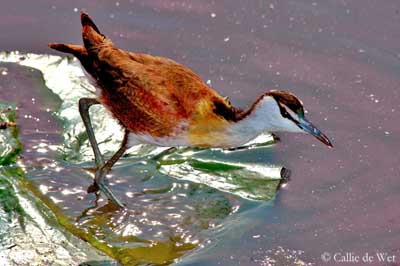
VOICE: SOUNDS BY XENO-CANTO
The African Jacana is a noisy bird. It utters sharp, ringing “krrrek”, also a shorter, rapid, loud and raspy “kreep-kreep-kreep” and a kind of barking “kyowrrr”.
The alarm calls are loud and noisy. While flying, it gives a rattling screech.
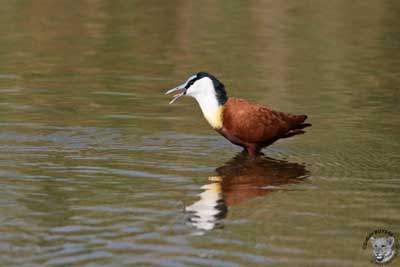
HABITAT :
The African Jacana frequents the freshwater wetlands with floating vegetation, and especially lily pads and other emergent plants in swamps and marshes.
It shelters in the taller aquatic vegetation which provides it a good cover. It spends most of its life on these large floating leaves.
RANGE:
The African Jacana breeds in wetlands throughout sub-Saharan Africa, but it avoids the forested regions and the arid areas.
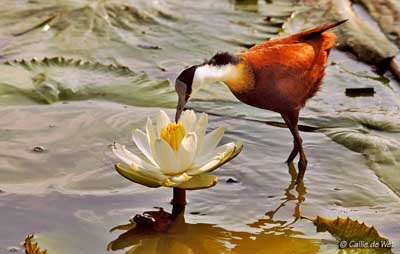
BEHAVIOUR:
The African Jacana feeds on aquatic insects and larvae, worms, snails and other arthropods. It may take seeds sometimes, when it forages on open cultivated areas.
It searches for preys by walking on the floating vegetation, thanks to the very long toes which spread the weight of its body over larger area.
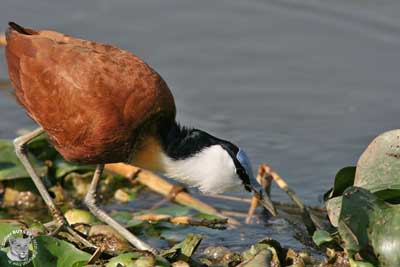
It gleans the preys from the surface, but it also turns over the lily pads with the bill or even with the toes by grasping the edges in search of food. It is also able to catch flying insects.
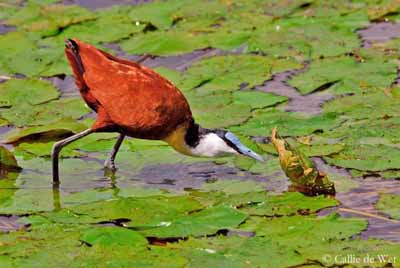
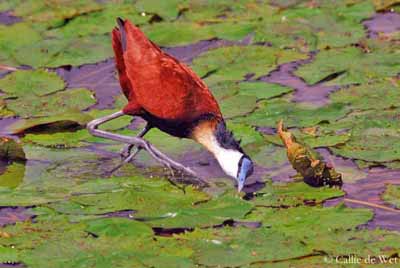
The African Jacana is a good swimmer and diver. When foraging, it swims over open water from one vegetated area to another.
To avoid predators, it can swim underwater, and in the same situation, the chicks can stay underwater for a moment with only the bill tip above the surface, and they swim as well as the adults.
If threatened, the bird raises its wings in aggressive posture to the predator as a visual signal. It also utters raucous calls if the intruder flies across the territory.
Outside the breeding season, this species is gregarious and may form very large flocks.
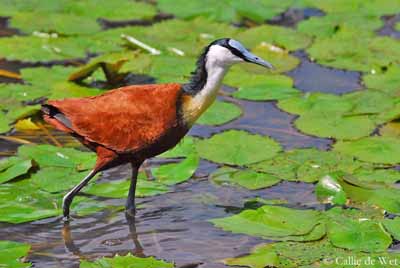
The mating system of the African Jacana is reversed. The male performs all the nesting duties while the female has access to several males and defends the territories against other females.
The courtship displays are fairly simple. Both sexes solicit. They display from a loose nest platform, by circling each other, walking with low head in order to enhance the blue-grey frontal shield. The female crouches and the male pecks at her body before to mount her. These displays can be repeated 4 to 5 times, but the cloacae contact occurs in only a small proportion of solicitations.
The African Jacana does not migrate but can be very nomadic in response to the water levels.
FLIGHT:
The African Jacana usually flies over short distances on rounded wings. The legs hang or are held straight out behind. This bird is a weak flier.
REPRODUCTION:
The African Jacana can breed all year round in permanent wetlands, or seasonally according to the water levels.
The male performs the nesting duties. It builds the nest, often on small floating islands over deep water. The loose nest is a partially submerged pad of marshy vegetation, but it extends to about 2 centimetres above the surface. It may be moved if the flooding threatens.

The female lays 4 eggs, but not necessarily on the nest. She can lay the eggs on the floating vegetation without nest. The eggs are pale brown with conspicuous black markings, making them almost invisible. They are very glossy.
The male starts to incubate after the 3rd egg, and during about 20-26 days. During the warmest hours of the day, it spends more time shading the eggs than incubating.
It also may move the eggs to a new nest-site, and for that, it carries them under its wings.
When the chicks hatch, the eggshells are removed and carried away from the nest. The downy chicks are precocial. They have pale and dark brown stripes above, and the underparts are white.
The male does not feed them, but it accompanies the young while they feed themselves. It broods them under its wings, and can carry them as for the eggs.
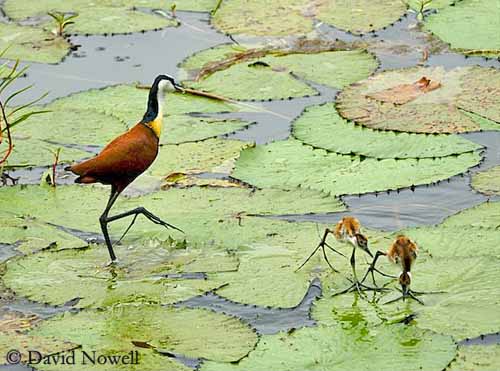
The young remain with the male for a period of 40 to 70 days. They reach the full adult plumage at about one year.
DIET:
The African Jacana feeds on insects and larvae, worms, snails, molluscs and crustaceans, spiders and some seeds.
It gleans the preys from the surface and can catch flying insects.
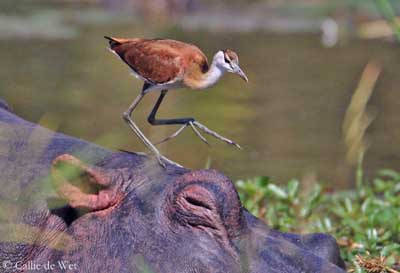
PROTECTION / THREATS / STATUS:
The African Jacana is usually common to abundant throughout most of the range. The species may be locally threatened by habitat loss, flooding, drainage of wetlands and overgrazing.
Eggs and chicks are preyed upon by aquatic snakes.
The Water lilies are destroyed by the invasive introduced nutria (Myocastor coypus), but the jacana is able to nest on other floating plants such as the exotic water fern of genus Salvinia.
However, this species is evaluated as Least Concern and not threatened at this moment.
